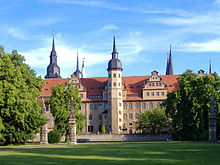Saxony-Merseburg
|
Territory in the Holy Roman Empire |
|
|---|---|
| Saxony-Merseburg | |
| coat of arms | |

|
|
| Arose from | Sharing of course axes |
| Form of rule | Secondary school principality |
| Ruler / government | duke
|
| Capitals / residences | Merseburg |
| Dynasties | Sideline of the Albertine Wettins |
| Denomination / Religions | Lutheran |
| Language / n |
German
|
| Incorporated into |
Electoral Saxony
|
The Principality of Saxony-Merseburg was a territory of the Holy Roman Empire and existed from 1656/57 to 1738 with the Merseburg residence . It was owned by a sideline of the Albertine Wettins .
Emergence
The Saxon elector Johann Georg I decreed in his will of July 20, 1652 that his three younger sons should receive secondary school principalities. After the elector died on October 8, 1656, the " Friend Brothers Main Settlement " was concluded on April 22, 1657 in Dresden and another settlement in which the three territories and the associated sovereign rights were finally delimited and in which it was the Johann brothers George II succeeded in achieving partial success in terms of their striving for sovereignty. The duchies of Saxony-Weißenfels , Saxony-Zeitz and Saxony-Merseburg emerged.
Prince Christian, the third eldest son, received, among other things , the castles, towns, municipalities and offices of Merseburg , Plagwitz , Rückmarsdorf , Delitzsch (with Delitzsch Castle ), Bad Lauchstädt , Schkeuditz , Lützen , which had previously largely been part of the Merseburg Monastery, which was secularized during the Reformation in 1562 , Bitterfeld , Zörbig , the county of Brehna and the margraviate of Niederlausitz , including the towns and castles of Calau , Luckau , Lübben , Doberlug , Finsterwalde , Döbern , Forst and Guben .
The area of Sachsen-Merseburg extended right up to the city limits of Leipzig. The customs place was today's district of Lindenau .
Associated offices
| Office | circle |
|---|---|
| Office Merseburg (also called "Kitchen Office") | Merseburg Monastery |
| Office Lauchstädt | Merseburg Monastery |
| Office Lützen with Office Zwenkau | Merseburg Monastery |
| Office Schkeuditz | Merseburg Monastery |
| Delitzsch Office | Leipzig district |
| Office Zörbig | Leipzig district |
| Finsterwalde Office | Meissnian circle |
| Office Bitterfeld | Kurkreis |
| Margraviate Niederlausitz |
Sovereigns
- 1656–1691 Christian I (born October 27, 1615 in Dresden ; † October 18, 1691 in Merseburg )
- 1691–1694 Christian II (born November 19, 1653 in Merseburg ; † October 20, 1694 ibid)
- 1694–1694 Christian III. Moritz (born November 7, 1680 in Merseburg ; † November 14, 1694 ibid), under the administration of Elector Friedrich August I of Saxony and under the tutelage of his mother Erdmuth Dorothea von Sachsen-Zeitz
- 1694–1731 Moritz Wilhelm (born February 5, 1688 in Merseburg ; † April 21, 1731 ibid), until 1712 under the administration of Elector Friedrich August I of Saxony and under the tutelage of his mother Erdmuthe Dorothea von Sachsen-Zeitz
- 1731–1738 Heinrich (born September 2, 1661 in Merseburg ; † July 28, 1738 in Doberlug ), previously Duke of Saxony-Merseburg-Spremberg
After the death of the last male heir of the Saxon branch line Sachsen-Merseburg, the duchy fell back to Electoral Saxony .
Secondary lines
In order to be able to look after his three sons who were born after him, Duke Christian I assigned them their own small domains as appanages while he was still alive , but these remained dependent on the main line and their sovereign rights were severely limited. They are named after the residences of their owners and died out again when they died, as none of them had living offspring. Before that, the Spremberg line succeeded in inheriting the main Merseburg line.
- until August 1715 (born February 15, 1655 in Merseburg , † March 27, 1715 in Zörbig ), Duke of Saxony-Merseburg-Zörbig
- until 1690 Philipp (born October 26, 1657 in Merseburg , † July 1, 1690 in Fleurus ), Duke of Saxony-Merseburg- Lauchstädt
- until 1731 Heinrich (born September 2, 1661 in Merseburg , † July 28, 1738 in Doberlug ), Duke of Saxony-Merseburg-Spremberg (inherits Saxony-Merseburg 1731)
literature
- Martina Schattkowsky , Manfred Wilde (Hrsg.): Saxony and his secondary education. The subsidiary lines Weißenfels, Merseburg and Zeitz (1657–1746). Writings on Saxon History and Folklore, Volume 33. Leipziger Universitätsverlag, Leipzig 2010, ISBN 978-3-86583-432-4 .
- Johann Hübners ... three hundred and three and thirty genealogical tables, tab. 170
- Manfred Wilde : The Baroque Delitzsch Palace as the widow's seat of the Dukes of Saxony-Merseburg. In: Baroque princely residences on Saale, Unstrut and Elster , ed. from the museum association The five unequal e. V., Michael Imhof Verlag, Petersberg 2007, pp. 264-276, ISBN 978-3-86568-218-5 .

